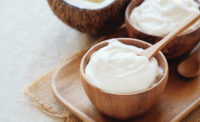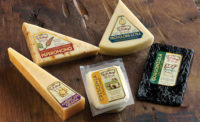Ana Gumabon has a well-stamped passport. Like any globetrotter, she jumps at the chance to sample the local fare while in-country, especially the sweets.
“I’ve visited many Asian countries, Dubai and a few European countries,” she said. “I loved the many varieties of desserts I tasted.”
Gumabon isn’t just any globetrotter. She’s director of research and development at California Custom Fruits & Flavors, Irwindale, Calif. In that capacity, she is duty-bound to engage in some serious culinary exploration for flavor inspiration. So when she declared, whilst rhapsodizing about Asia’s tropical fruits and treats made from coconut milk and sweet rice, and the baklavas of the Middle East doused with honey, rose syrup and nuts, “Many of these concepts can be translated into dairy products for the U.S. market,” she literally meant business.
A flavor quest
In kitchens across America, it really is a small world after all. Citing Mintel data, flavor expert Azeem Mateen noted that 74% of U.S. households have either prepared or cooked ethnic foods at home and 59% eat ethnic foods because they like to try new flavors.
That is a sure sign that “as consumers’ palates demand more complex and intense flavors, we’ll continue to see ethnic flavors push the envelope in terms of culinary inspirations and eventually products on the shelf,” said Mateen, the marketing manager of sweet flavors for Sensient Flavors, Hoffman Estates, Ill.
America’s long-reigning ethnic triumvirate — Italian, Chinese and Mexican cuisines — are yielding to flavors from Spain, Thailand, Greece, India, Cuba, Morocco, Peru, Korea, you name it. What unites each cuisine on that list — and so appeals to today’s consumers — is complexity.
“Independent market intelligence and our own data gathering have shown that consumers are responsive to more complex flavors — sweet and spicy, sour and savory,” said Michael Swenson, director of business development for Sensient Natural Ingredients, Turlock, Calif. “Many ethnic cuisines feature these types of flavors.”
Stepping out (of a comfort zone)
But if American consumers are so keen on culinary complexity with an international accent, why does the selection in the dairy case still taste so domestic? Amy Loomis of Synergy Flavors, Wauconda, Ill., suggested that the shallow pool of international flavors in dairy products may stem from a greater focus on product formats at the expense of new flavor profiles.
Also, she noted, dairy products “are often tied to sweeter profiles,” which can limit the selection of international profiles that dairy developers might consider exploring.
Gumabon said ethnic flavors usually involve unique seasonings and spices that might be compatible with a savory snack or sauce base, but are “harder to adapt to sweet dairy products or the tart flavor of yogurt.”
The mainstreaming of emerging international flavors within the dairy category will be a gradual process, said Anton Angelich, the group vice president of marketing for Virginia Dare, Brooklyn, N.Y.
Though mass media and social media can heighten consumers’ awareness of new and unknown foods, “it really takes the actual trial of cooking and tasting for something to catch on,” he said. Once word spreads about flavors from food trucks or restaurants, “established food and beverage professionals take notice and try to incorporate these new tastes into their product lines,” he said.
Pioneering profiles
Ed McIntosh would like to see food processors take more risks. The marketing manager for Flavorchem Corp., Downers Grove, Ill., said “the industry should be less conservative with flavors and offer new line extensions with unique profiles and blends. This will offer greater opportunities to enter new markets.”
To be fair, McIntosh credited dairy marketers with pioneering new profiles inspired by the flavors of Latin America in particular, which he surmised will “work best with today’s consumers because of our ever-changing demographics.”
The U.S. Census Bureau estimates Hispanics will be 31% of the American population by 2060. Their influence on American foodways will be inescapable for the foreseeable future. For fans of flavor, that’s a very good thing.
“Dulce de leche was one of the first Hispanic-originated flavors to gain national popularity in dairy,” Angelich said. “And tropical fruits that are popular with Hispanics, such as mango, guava, pineapple, lime and passion fruit, have also gained a strong presence in mainstream American dairy products.”
Flan, cajeta, tres leches, churros and rompope are other Latin American profiles that could potentially become part of the American dairy flavor repertoire, he said.
Bottoms up
Beverages are often the fastest and easiest categories for testing new flavors, Angelich said. That’s because once a processor develops a beverage brand and establishes the processing technology, “it’s a matter of applying the new flavor to the existing beverage, making sure it remains technically sound and then designing a new label,” he said. “In this way, it’s easy to test a new flavor’s viability in the market.”
Marie Cummings of David Michael & Co., Philadelphia, has already seen Mexican-chocolate profiles in dairy-based beverages.
“Their nuances make them appealing both in dairy and nondairy, but also in chocolate or coffee drinks,” she said. Cummings, who is David Michael & Co.’s manager of food applications and product development, said she also has noticed concepts like masala chai (the Indian tea flavored with cinnamon, cloves, cardamom, ginger and other warm, sweet spices) in ready-to-drink tea lattes and protein-rich recovery beverages.
The Greek culture
Cultured dairy foods and beverages (like kefir) have seen an expansion of flavor offerings. Greek-style yogurt is “a perfect vehicle” for ethnic flavors,” Mateen said, pointing to savory Greek yogurt dips that have gone “beyond traditional flavors and are compelling ethnic fusions.”
And if yogurt proves the theory that dairy doesn’t have to be sweet, ethnic cheeses corroborate it. Sensient’s Swenson called the cheese category a segment that is “ripe for adding some savory flavors.”
Because cheese is inherently savory, “it serves as an excellent platform on which to add vegetables, spices and the like,” Swenson said. The next step is the addition of chili blends. A Moroccan harissa in a Havarti or Gouda would be “a delicious direction,” he said.
Just desserts
Culinary wanderlust notwithstanding, there’s still something about sweet dairy desserts that humans can’t resist. Sweet, indulgent and fruit flavors have traditionally (and successfully) been the source of many new dairy flavors, said Angelich.
“I think desserts from Southeast Asian countries that use fruits will be popular and easily adaptable to dairy,” Gumabon said. She also predicted that the Middle East’s rich catalog of confections will win converts.
“Typically, these use cream or sweetened condensed milk, nuts, honey, sweet syrup, dried fruit, cheeses and phyllo dough” — all of which are easy for Americans to love. “Even a bit of spice or floral tastes, like cardamom and rose, will work,” she said.
Looking to Japan, Loomis and her team’s culinary experts identified green tea, yuzu and melon as promising flavors for Japanese-style gelato. “Similarly,” she continued, “exposure to Cuban cuisine as more people travel there will acquaint consumers with its indigenous foods and flavors,”including dessert-friendly profiles like cooked caramel, citrus and coffee.
Peggy Pellichero, senior food technologist and dairy team leader at David Michael & Co., pointed to global spice blends as “untapped markets for ice cream.” Apollonia spice — a blend of cocoa, orange blossom and pepper that shows up in Mediterranean dishes — “would be a delicious ice cream flavor,” she said.
Clarkson noted that ice cream bars are “huge in hot climates,” with profiles like horchata in Mexico, sweet mung-bean milk in Taiwan and coconut milk in Thailand all local hits.
Is close enough OK?
But is authenticity really the goal when adapting international flavors for domestic dairy? Some maintain that it is.
“Authenticity is extremely important,” McIntosh said.
But Gumabon said, “I don’t think authenticity is important in this case.”
With some ingredients tough to get in the United States, formulation compromises are all but inevitable. Further, Gumabon said, “These recipes must be modified to satisfy the American palate if the goal is to capture more customers outside the particular ethnic group.”
The lesson: Authenticity is as fluid as our population. As Angelich pointed out, “In a sense there is an American ethnicity, and along with that come regional food heritages and preferences” that comprise everything from key lime pie and red velvet cake to Mississippi mud pie and New York cheesecake.
Ethnic, he said, can be simply “a sense of identity when people have a shared common heritage, culture, history, language and geographical origin.”
And that tastes great no matter where you come from.



